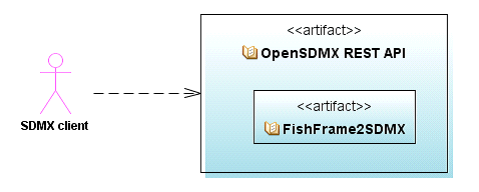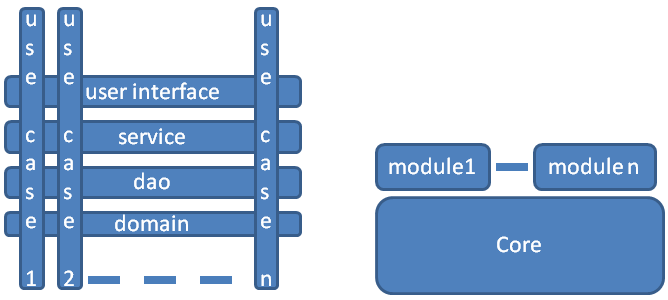OpenSDMX
OpenSDMX is described in it's own pages.
In iMarine, services can be developed for a range of SDMX related services that assist communities to consume and produce SDMX data. Several proposals have been brought forward, and these include:
Generic CodelistManager
On the left of below image you see the horizontal physical layers of the architecture. Vertically the usecases/functions.
On the right you see that the codelist manager(CM) consists of n modules. All modules use the core. One module implements one or more usecases. A module would ideally be packed as a portlet, running in a portletcontainer.
The different partners in the project are: iMarine, MDM (FAO) and the BoI. Estimation of commonalities (for each partner as percentage of the total software stack): ui 60%, service 70%, dao 80%, domain 90%.
<xh3>Project plan</xh3>
- Now – December 2012:
- The iMarine project designs and develops the CM.
- BoI and MDM will advise and deliver requirements.
- December 2012:
- BoI and/or MDM decide to prolong their participation or to start building their own CM.
- The iMarine project will continue in any case with the by them existing CM.
The CM is an autonomous open source project, hosted on SourceForge. From the very beginning, a user interface designer is involved.
<xh4>Strengths</xh4>
- The mix of partners guarantees the right input on requirements, domain, conceptual and technical level.
- Even a worst case scenario will result in a win-win situation for each partner.
<xh4>Risks</xh4>
- BoI uses Oracle, iMarine uses Postgres. It is not clear whether a database transparent approach can be agreed upon between all partners.
- Designing a modular and agile architecture as shown above is a precondition for success and requires skilled engineers with an agile and collaborative mindset. It is not clear whether all partners have engineers with such a skillset.
- BoI does not use currently a portletcontainer. It is not clear whether the BoI can be convinced to use the Liferay PortletContainer (as is used in the D4ScienceAn e-Infrastructure operated by the D4Science.org initiative. infrastructure).
<xh4>Perspective</xh4>
- This project can never fail, even if the BoI and/or MDM are deciding to drop out in December 2012. In December 2012, all partners will have as a starting point:
- a well engineered domain model
- a well engineered architecture
- a working application to develop further on, to eventually converge from.
- There is a good chance that there will be no drop outs in December 2012 because all partners seem to have the right mindset, need more or less the same solution and are willing to collaborate.
- The role of BoI is informal in the iMarine project because they are not an official iMarine project partner. Their involvement is crucial because of their expertise and maturity level on the subject.
OpenSDMX CodelistManager
The further development of OpenSDMX in the iMarine project context aims to position OpenSDMX, and thus the iMarine project, as
- a supplier of services to other SDMX infrastructures, or
- a range of services that can interpret SDMX, e.g. by offering SDMX data access and processing services.
Where using the word D4ScienceAn e-Infrastructure operated by the D4Science.org initiative., the D4ScienceAn e-Infrastructure operated by the D4Science.org initiative. Infrastructure is meant, which is used in the iMarine project.
This document starts with describing premises and the SDMX Scoping, followed by the proposed functions to implement:
- CodelistManager
- Validation/Curation
- Artifact Selector
- Data Visualization
- SDMX2RDF
In a related context, CNR has identified the SDMX processing as an opportunity to pursue. The use cases for data-mining and transformation that could benefit from the processing services are not described here.
Premises
Adopting OpenSDMX is lightweight. Clients may be reluctant to adopt D4ScienceAn e-Infrastructure operated by the D4Science.org initiative.. They may be exposed to D4ScienceAn e-Infrastructure operated by the D4Science.org initiative. capabilities through OpenSDMX, and consider to migrate services from OpenSDMX to D4ScienceAn e-Infrastructure operated by the D4Science.org initiative.. Doing so, OpenSDMX can be a cost-effective enabler for D4ScienceAn e-Infrastructure operated by the D4Science.org initiative., getting its clients familiar with D4ScienceAn e-Infrastructure operated by the D4Science.org initiative.. Therefore these premises are defined:
- OpenSDMX does not have a dependency with the D4ScienceAn e-Infrastructure operated by the D4Science.org initiative. infrastructure.
- All OpenSDMX artefacts are portable into the D4ScienceAn e-Infrastructure operated by the D4Science.org initiative. infrastructure.
- Developments are done in the context of the OpenSDMX community, directly on the OpenSDMX codebase and follow the OpenSDMX release lifecycle.
Scoping
The SDMX specification defines these artefacts: datastructure (DSD), metadatastructure, categoryscheme, conceptscheme, codelist, hierarchicalcodelist, organisationscheme, agencyscheme, dataproviderscheme, dataconsumerscheme, organisationunitscheme, dataflow, metadataflow, reportingtaxonomy, provisionagreement, structureset, process, categorisation, contentconstraint, attachmentconstraint, structure, metadata, schema, data
The artefacts written in bold are selected to be part of the iMarine project at this stage (datastructure, conceptscheme, organisationscheme, codelist, dataflow and data).
The artifact process can be further discussed to be taken on board or not. On the long term this one is definitely need to be taken into account because it can reflect the process of data and metadata in the system. The Bank of Italy is using their proprietary Expression Language for this purpose. Adopting either in D4ScienceAn e-Infrastructure operated by the D4Science.org initiative. will require at least a MOU with a large ‘SDMX’ partner. It will not be discussed here.
OpenSDMX is divided in 2 parts, core and plus. OpenSDMX-Core is the implementation of the SDMX REST specification with the concept of adapters. OpenSDMX-Plus contains all the functions which are additions to core, like CodelistManager, Validation, Artefact Selector, SDMX2RDF and DataVisualization.
See the diagram below for the dependencies of the different software components and how the components relate together.
CodelistManager
Functions distinguished for a CodelistManager are:
- Maintenance (adding, changing or deleting codes and/or descriptions)
- Importing from CSV/SDMX / RDF / FishFrame
- Versioning
- Publishing (of a new version)
- Validity (Where when for who is it authoritative / reference / candidate)
Possible contexts in which these functions need to be performed are
- The codelist is already stored in an existing datastore (a datastore can be a database or a data access layer):
- All functions are performed on this datastore (A).
- An initial codelist is loaded from the datastore and will be copied in the CodelistManager. The subsequent lifecycle will happen in the CodelistManager (B).
- The codelist is a file. The file is loaded in the CodelistManager. Most of functions are performed in the CodelistManager. Additions of codes may happen by uploading new codes for the Codelist (B).
Impact of Option A: the OpenSDMX instance does not have its own database.
Impact of option B, the OpenSDMX instance does have its own database.
Validation/Curation
Vision on this has been worked out already here: http://opensdmxdevelopers.wikispaces.com/Curation The discussion on the level of validation in the context of SDMX is currently led by Eurostat. Involved parties are the Bank of Italy, Metadata Technology, Agillis and FAO. Apart from the precise outcome of these discussions, it is clear that there is a need for an infrastructure which can load/cure/validate SDMX datasets.
SDMX Artefact Selector
This scenario is inspired by my interpretation of the data.fao.org principle:
- Guide the user to the data or metadata in a highly user friendly and pleasant way
- Give the data to the user
- So the user can go away to do whatever he wants to do with the data.
The data.fao.org offers a simple way to find SDMX data, using the SDMX REST API. There is a need for a user interface which leads the user in a simple way to the SDMX data and metadata. The SDMX Artefact Selector could also be called a SDMX Registry and Repository Browser.
SDMX2RDF
http://publishing-statistical-data.googlecode.com/svn/trunk/specs/src/main/html/index.html
There is an interesting group working on the transformation of the SDMX model into RDF. This work can be adopted in order to publish SDMX datasets also in RDF.
SDMX Data Visualization
In order to make data visible and findable for search engines, an user interface is needed to visualize the SDMX artefacts. The first artifact to visualize is the SDMX dataset. The DSD can be used to express the data in the different languages.
FishFrame2SDMX
FishFrame is an upcoming standard for data collection and dissemination in the Fisheries domain, read more here: http://km.fao.org/FIGISwiki/index.php/FishFrame
In addition, a dedicated section in this Cluster page outlines the FishFrame plans in iMarine.
IRD is using FishFrame for data dissemination. FishFrame as a standard and intention is similar to SDMX, however only for the Fisheries domain. IRD advised that a conversion from FishFrame to SDMX makes more sense than the other way around. Rational behind is that it is important to publish the FishFrame format according standards like SDMX, accepted outside the Fisheries community. Conversion from FishFrame to SDMX will also result in having a profound understanding how the two standards relate together. This is highly valuable knowledge for the iMarine project. Conversion from SDMX to FishFrame is not planned yet, however not excluded on the long term.
The picture below shows the position of the FishFrame2SMX converter:

The converter will generate SDMX codelists, datastructures and datasets.
FishFrame does not have a dissemination protocol like the SDMX REST API. OpenSDMX implements this protocol and the converter can be packaged as an adapter in order to publish FishFrame as SDMX artefacts through the SDMX REST API.

The above pattern can be applied one to one in D4ScienceAn e-Infrastructure operated by the D4Science.org initiative..
SDMX&JSON
SDMX datasets can be voluminous for large amount of data. This is a pure technical problem and can be solved. The SDMX community is working on JSON, but this is yet not really being picked up. The work to be done is described here: http://opensdmxdevelopers.wikispaces.com/Statistical+System+Architecture+Patterns#JSON
